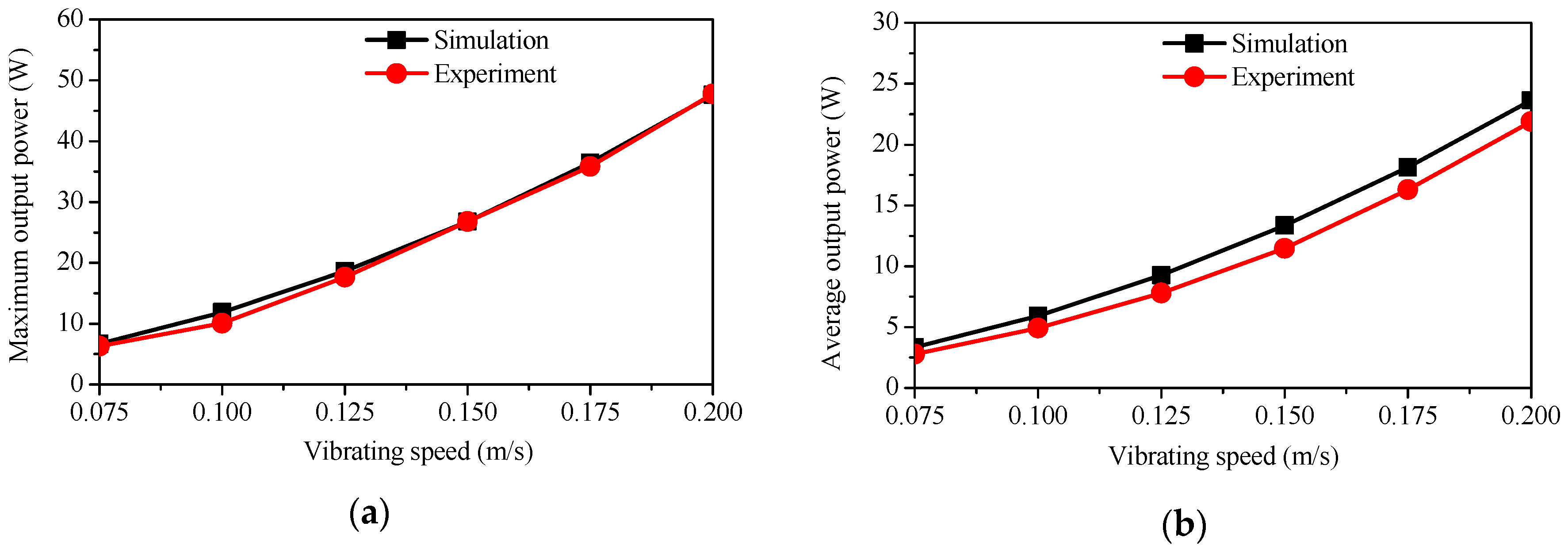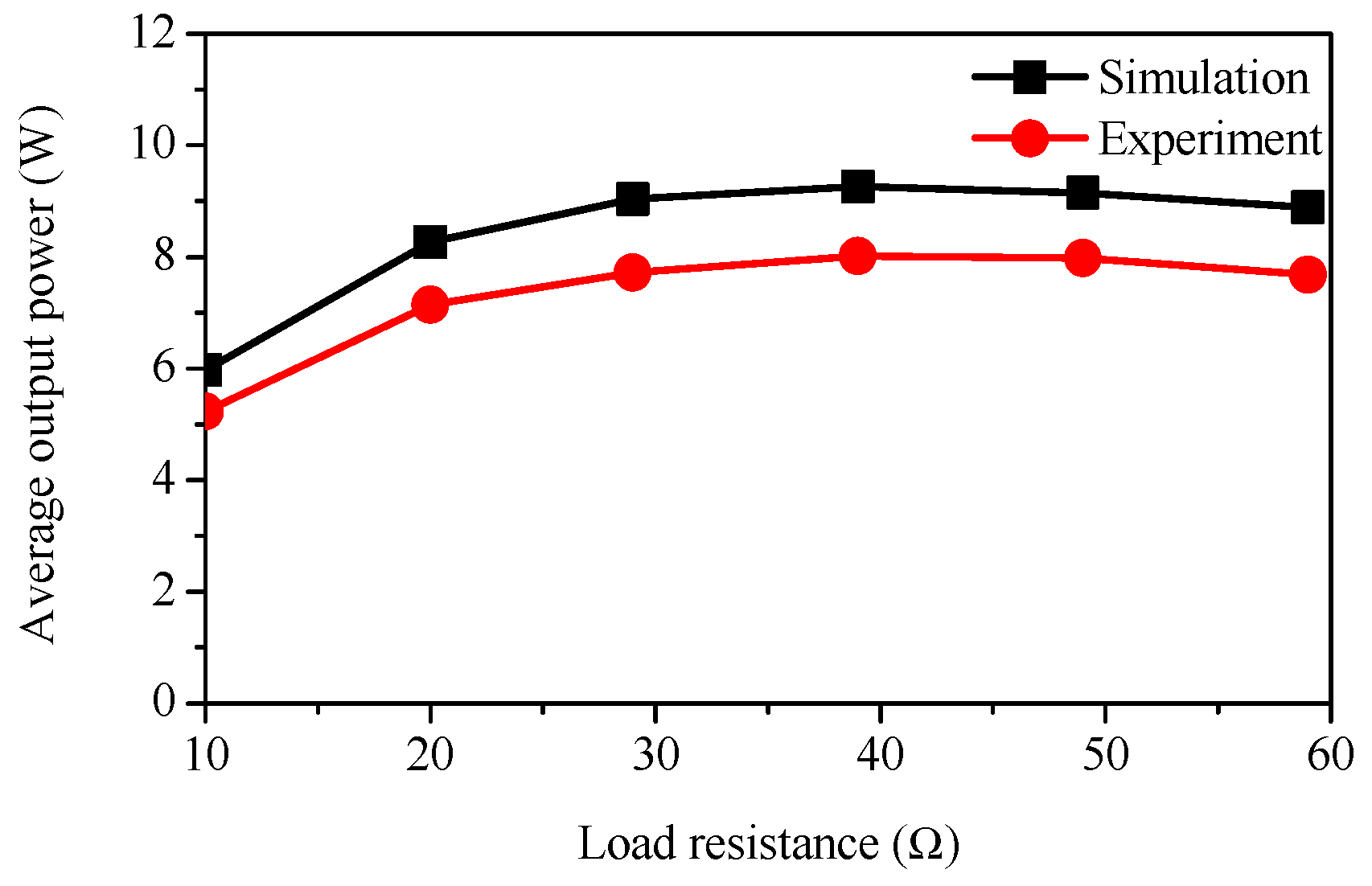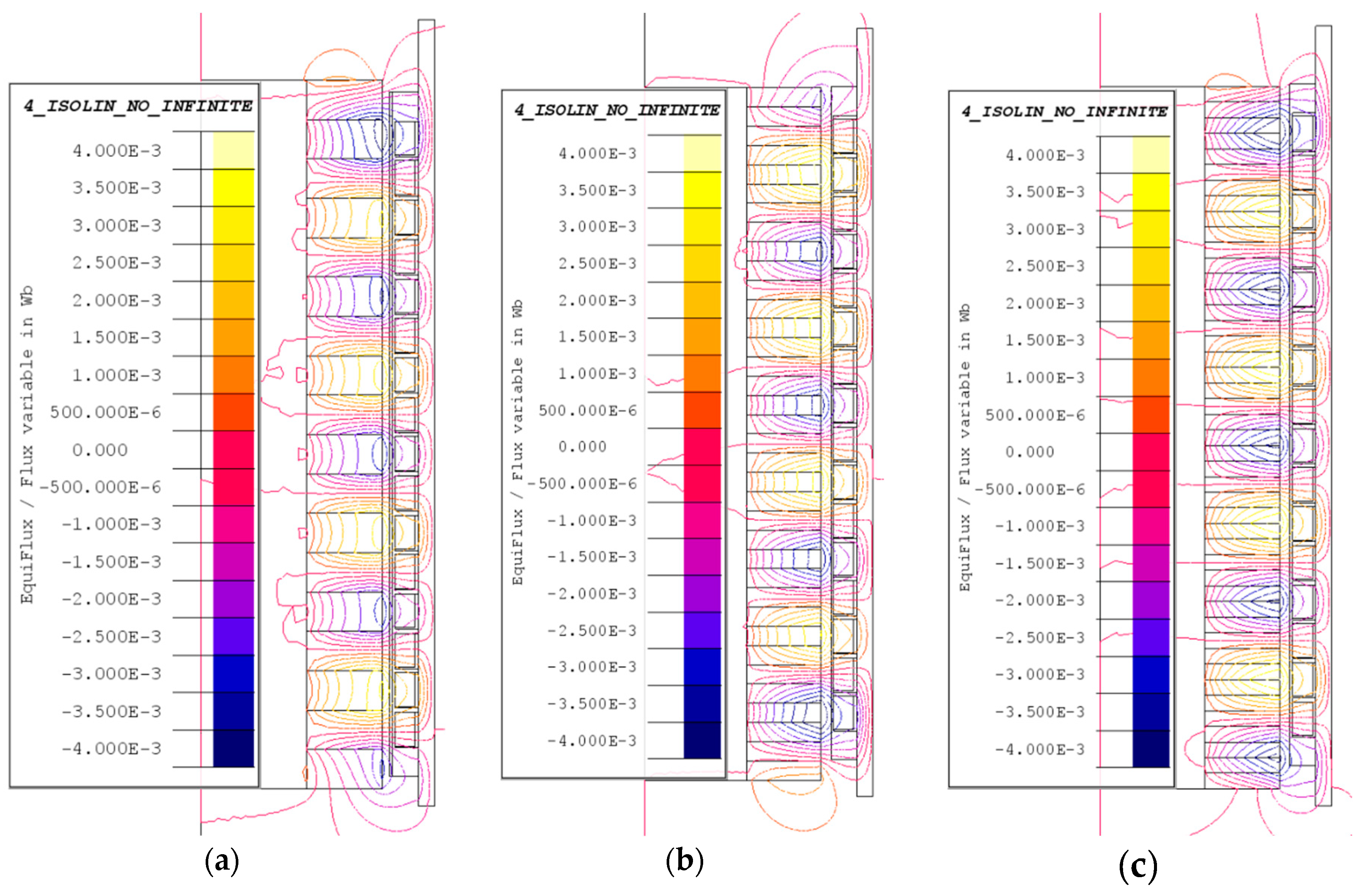Improvement of Tubular Permanent Magnet Machine Performance Using Dual-Segment Halbach Array
Abstract
:1. Introduction
2. Tubular Machine with Classical Halbach Array
2.1. Design Specifications
2.2. Validation with Experimental Data
3. Tubular Machine with Dual-Segment Halbach Array
4. Conclusions
Author Contributions
Acknowledgments
Conflicts of Interest
References
- Li, K.; Zhang, X.; Chen, H. Design Optimization of a Tubular Permanent Magnet Machine for Cryocoolers. IEEE Trans. Magn. 2015, 51, 1–8. [Google Scholar] [CrossRef]
- Wang, J.; Lin, Z.; Howe, D. Analysis of a short-stroke, single-phase, quasi-Halbach magnetised tubular permanent magnet motor for linear compressor applications. IET Electr. Power Appl. 2008, 2, 193–200. [Google Scholar] [CrossRef]
- Wang, J.; Howe, D.; Lin, Z. Design Optimization of Short-Stroke Single-Phase Tubular Permanent-Magnet Motor for Refrigeration Applications. IEEE Trans. Ind. Electron. 2010, 57, 327–334. [Google Scholar] [CrossRef]
- Shen, Y.; Lu, Q.; Ye, Y. Double-Stator Air-Core Tubular Permanent Magnet Linear Motor for Vehicle Active Suspension Systems. In Proceedings of the 2016 IEEE Vehicle Power and Propulsion Conference (VPPC), Hangzhou, China, 17–20 October 2016; pp. 1–6. [Google Scholar]
- Abdelkareem, M.A.A.; Xu, L.; Ali, M.K.A.; Elagouz, A.; Mi, J.; Guo, S.; Liu, Y.; Zuo, L. Vibration energy harvesting in automotive suspension system: A detailed review. Appl. Energy 2018, 229, 672–699. [Google Scholar] [CrossRef]
- Zhang, R.; Wang, X.; John, S. A Comprehensive Review of the Techniques on Regenerative Shock Absorber Systems. Energies 2018, 11, 1167. Available online: https://www.mdpi.com/1996-1073/11/5/1167 (accessed on 29 October 2018). [CrossRef]
- Cappelli, L.; Marignetti, F.; Mattiazzo, G.; Giorcelli, E.; Bracco, G.; Carbone, S.; Attaianese, C. Linear Tubular Permanent-Magnet Generators for the Inertial Sea Wave Energy Converter. IEEE Trans. Ind. Appl. 2014, 50, 1817–1828. [Google Scholar] [CrossRef]
- Aderinto, T.; Li, H.; Aderinto, T.; Li, H. Ocean Wave Energy Converters: Status and Challenges. Energies 2018, 11, 1250. [Google Scholar] [CrossRef]
- Xia, T.; Yu, H.; Shi, Z.; Guo, R. Comparative Analysis and Experimental Verification of a Linear Tubular Generator for Wave Energy Conversion. Energies 2018, 11, 1707. Available online: https://www.mdpi.com/1996-1073/11/7/1707/htm (accessed on 29 October 2018). [CrossRef]
- Design and Characterization of an Electromagnetic Energy Harvester for Vehicle Suspensions—IOPScience. Available online: http://iopscience.iop.org/article/10.1088/0964-1726/19/4/045003/meta (accessed on 4 June 2018).
- Tang, X.; Lin, T.; Zuo, L. Design and Optimization of a Tubular Linear Electromagnetic Vibration Energy Harvester. IEEE/ASME Trans. Mechatron. 2014, 19, 615–622. [Google Scholar] [CrossRef]
- Shen, Y. Novel Permanent Magnet Brushless Machines Having Segmented Halbach Array. Ph.D. Thesis, University of Sheffield, Sheffield, UK, 2013. [Google Scholar]
- Ma, C.; Zhao, W.; Qu, L. Design optimization of a linear generator with dual Halbach array for human motion energy harvesting. In Proceedings of the 2015 IEEE International Electric Machines Drives Conference (IEMDC), Coeur d’Alene, ID, USA, 10–13 May 2015; pp. 703–708. [Google Scholar]
- Duong, M.-T.; Chun, Y.-D.; Han, P.-W.; Park, B.-G.; Bang, D.-J.; Lee, J.-K. Design of An Electromagnetic Energy Harvesting System Applied to The Shock Absorber of A Sport Utility Vehicle. Available online: http://www.dbpia.co.kr (accessed on 4 June 2018).
- Duong, M.-T.; Chun, Y.-D. Design of an Electromagnetic Energy Harvesting System Applied to Shock Absorber in Sport Utility Vehicle. J. Magn. 2018, 23, 392–398. [Google Scholar] [CrossRef]
- Goldner, R.B.; Zerigian, P. Electromagnetic Linear Generator and Shock Absorber. U.S. Patent No. 6,952,060, 4 October 2005. [Google Scholar]











| Item | Value |
|---|---|
| Vibration speed (m/s) | 0.25 |
| Vibration frequency (Hz) | 10 |
| Stroke length (mm) | 11.25 |
| Length, L (mm) | 243 |
| Outer diameter, D (mm) | 160 |
| PM thickness, tim (mm) | 26.0 |
| Radial PM width, wrm (mm) | 13.5 |
| Axial PM width, wam (mm) | 13.5 |
| Pole pitch, τp (mm) | 27.0 |
| Coil window thickness, tc (mm) | 8.0 |
| Coil window width, wc (mm) | 12.1 |
| Mechanical air gap, g (mm) | 4.3 |
| Inner iron thickness, tii (mm) | 1.6 |
| Added iron thickness, tia (mm) | 16.0 |
| Back iron thickness, tb (mm) | 5.6 |
| Wire diameter, wr (mm) | 0.6 |
| Number of winding/slot, turns | 180 |
| Number of poles, Np | 8 |
| Number of slots, Ns | 16 |
| Back iron material | S20C |
| PMs material | NdFeB—N40SH; Br = 1.26T (at 20 °C); μr = 1.05 |
| Item | Classical Halbach Array | 4-Segment | 5-Segment |
|---|---|---|---|
| Vibration speed (m/s) | 0.25 | ||
| Vibration frequency (Hz) | 10 | ||
| Stroke length (mm) | 11.25 | ||
| Length (mm) | 243 | ||
| Diameter (mm) | 160 | ||
| Pole pitch, τp (mm) | 27 | ||
| Number of segments/pole pitch | 2 | 4 | 5 |
| Width of each segment (mm) | 13.5 | 6.75 | 5.4 |
| Magnetized angle of mid-magnet | --- | 45° | 30° |
| Items | Classical Halbach Array | 4 Segment | 5 Segment | |
|---|---|---|---|---|
| Radial flux density (T) | Max | 0.55 | 0.59 | 0.58 |
| RMS | 0.36 | 0.39 | 0.39 | |
| Maximum induced voltages (V) | Phase 1 | 54.10 | 57.98 | 57.86 |
| Phase 2 | 17.05 | 18.53 | 19.12 | |
| Output Power (W) | Maximum | 76.09 | 87.10 | 87.38 |
| Average | 37.78 | 43.53 | 43.47 | |
© 2018 by the authors. Licensee MDPI, Basel, Switzerland. This article is an open access article distributed under the terms and conditions of the Creative Commons Attribution (CC BY) license (http://creativecommons.org/licenses/by/4.0/).
Share and Cite
Duong, M.-T.; Chun, Y.-D.; Bang, D.-J. Improvement of Tubular Permanent Magnet Machine Performance Using Dual-Segment Halbach Array. Energies 2018, 11, 3132. https://doi.org/10.3390/en11113132
Duong M-T, Chun Y-D, Bang D-J. Improvement of Tubular Permanent Magnet Machine Performance Using Dual-Segment Halbach Array. Energies. 2018; 11(11):3132. https://doi.org/10.3390/en11113132
Chicago/Turabian StyleDuong, Minh-Trung, Yon-Do Chun, and Deok-Je Bang. 2018. "Improvement of Tubular Permanent Magnet Machine Performance Using Dual-Segment Halbach Array" Energies 11, no. 11: 3132. https://doi.org/10.3390/en11113132





